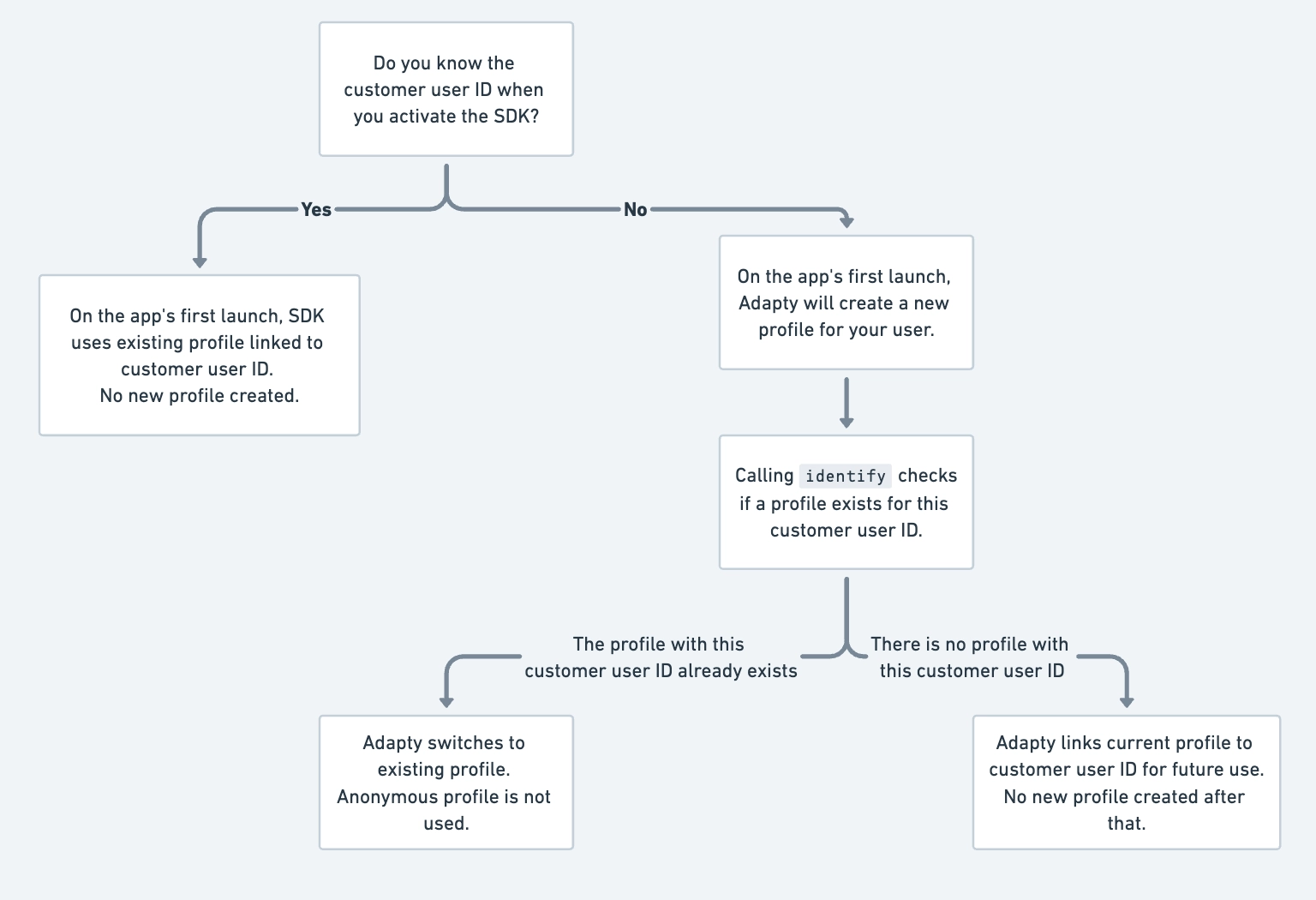Identify users in Capacitor SDK
How you manage users' purchases depends on your app's authentication model:
- If your app doesn't use backend authentication and doesn't store user data, see the section about anonymous users.
- If your app has (or will have) backend authentication, see the section about identified users.
Key concepts:
- Profiles are the entities required for the SDK to work. Adapty creates them automatically. They can be anonymous (without customer user ID) or identified (with customer user ID).
- Customer user IDs are optional identifiers you create for Adapty to link your users to their Adapty profiles.
Here is what is different for anonymous and identified users:
| Anonymous users | Identified users | |
|---|---|---|
| Purchase management | Store-level purchase restoration | Maintain purchase history across devices through their customer user ID |
| Profile management | New profiles on each reinstall | The same profile across sessions and devices |
| Data persistence | Anonymous users' data is tied to device/installation | Identified users' data persists across devices and sessions |
Anonymous users
If you don't have backend authentication, you don't need to handle authentication in the app code:
- When the SDK is activated on the app's first launch, Adapty creates a new profile for the user.
- When the user purchases anything in the app, this purchase is associated with their Adapty profile and their store account.
- When the user re-installs the app or installs it from a new device, Adapty creates a new empty profile on activation.
- If the user has previously made purchases in your app, by default, their purchases are automatically synced from the App Store on the SDK activation.
Identified users
- If a profile doesn't have a customer user ID yet (meaning, the user isn't signed in), when you send a customer user ID, it gets associated with that profile.
- If it is a re-installation, signing in, or installation from a new device, and you have sent their customer user ID before, a new profile is not created. Instead, we switch to the existing profile associated with the customer user ID.
You have two options to identify users in the app:
-
During login/signup: If users sign in after your app starts, call
identify()with a customer user ID when they authenticate. -
During the SDK activation: If you already have a customer user ID stored when the app launches, send it when calling
activate().
By default, when Adapty receives a purchase from a Customer User ID that is currently associated with another Customer User ID, the access level is shared, so both profiles have paid access. You can configure this setting to transfer paid access from one profile to another or disable sharing completely. See the article for more details.

During login/signup
If you're identifying users after the app launch (for example, after they log into your app or sign up), use the identify method to set their customer user ID.
- If you haven't used this customer user ID before, Adapty will automatically link it to the current profile.
- If you have used this customer user ID to identify the user before, Adapty will switch to working with the profile associated with this customer user ID.
When creating a customer user ID, save it with your user data so you can send the same ID when they log in from new devices or reinstall your app.
try {
await adapty.identify({ customerUserId: "YOUR_USER_ID" });
// successfully identified
} catch (error) {
// handle the error
}
During the SDK activation
If you already know a customer user ID when you activate the SDK, you can send it in the activate method instead of calling identify separately.
If you know a customer user ID but set it only after the activation, that will mean that, upon activation, Adapty will create a new empty profile and switch to the existing one only after you call identify.
You can pass either an existing customer user ID (the one you have used before) or a new one. If you pass a new one, a new profile created on the activation will be automatically linked to the customer user ID.
To exclude created empty profiles from the dashboard analytics, go to App settings and set up Installs definition for analytics.
await adapty.activate({
apiKey: "YOUR_PUBLIC_SDK_KEY",
params: {
customerUserId: "YOUR_USER_ID"
}
});
Log users out
If you have a button for logging users out, use the logout method. This creates a new anonymous profile ID for the user.
try {
await adapty.logout();
// successful logout
} catch (error) {
// handle the error
}
To log users back into the app, use the identify method.
Allow purchases without login
If your users can make purchases both before and after they log into your app, you don't need to do additional setup:
Here's how it works:
- When a logged-out user makes a purchase, Adapty ties it to their anonymous profile ID.
- When the user logs into their account, Adapty switches to working with their identified profile.
- If it is an existing customer user ID (the customer user ID is already linked to a profile), Adapty syncs its transactions automatically.
- If it is a new customer user ID (e.g., the purchase has been made before registration), Adapty assigns the customer user ID to the current profile, so all the purchase history is maintained.